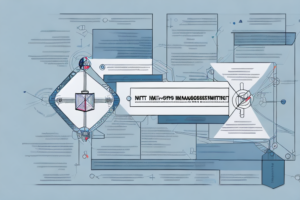What is system inventory update process in RMF?

A computer system with a diagram showing the process of updating its inventory
When it comes to managing and protecting your organization’s information system, there is no substitute for a robust and effective risk management framework. One critical component of any such framework is the regular and thorough update of your system inventory to ensure that you have a complete and accurate understanding of the technology assets you have and those you need. In this article, we will explore what system inventory update process in RMF is and why it is essential for your organization’s security posture.
Understanding the Basics of RMF
Before diving into the details of system inventory update process in RMF, let’s first understand the basics of RMF. Risk Management Framework, or RMF, is a structured approach to managing information security and is used by the federal government and many private organizations. It is a cyclical process consisting of six steps, with each step building upon the previous one. The six steps of RMF are:
- Categorize the information system and the information processed, stored, or transmitted by the system;
- Select and implement security controls for the system;
- Assess the security controls to determine their effectiveness;
- Authorize the system to operate;
- Monitor the system and assess changes to the system or its environment;
- Repeat the previous five steps throughout the system’s operational life cycle.
RMF is a crucial process for ensuring the security of information systems. It helps organizations identify and manage risks to their information systems and the information processed, stored, or transmitted by those systems. By following the six steps of RMF, organizations can ensure that their information systems are secure and that they are meeting regulatory requirements. It is important to note that RMF is not a one-time process, but rather a continuous cycle that must be repeated throughout the system’s operational life cycle to ensure ongoing security.
Importance of System Inventory Update in RMF
A system inventory is a comprehensive, up-to-date list of all assets and resources that comprise your information system. Regular system inventory updates are critical to maintaining a complete and accurate list of all IT assets within an organization. A comprehensive understanding of the information system’s inventory is crucial for an organization’s security posture as it forms the baseline for all risk management activities. Without an accurate accounting of the various IT assets within an organization, it would be difficult to ensure effective risk management.
Benefits of Regular System Inventory Update in RMF
Regular system inventory update in RMF has several benefits for an organization. For instance, it enables the organization to detect and respond to security risks proactively. By keeping the IT inventory up to date, an organization can identify new risks that emerge due to changes in its technology environment. An accurate inventory also ensures that security controls are kept up to date to protect the organization’s infrastructure against emerging threats. An organization can also use a comprehensive inventory to identify obsolete or decommissioned assets that need to be removed from the network, streamlining the maintenance and the overall performance of the IT infrastructure.
The Role of System Inventory in Risk Management
System inventory plays a critical role in risk management. It provides a baseline for the identification and assessment of the IT risks an organization faces. The inventory is used to identify the different IT assets deployed, their location, and the level of protection required for each asset. An accurate inventory allows the organization to tailor their system security to the level of risk associated with specific assets. This ensures that the security measures put in place are adequate and in line with the organization’s risk appetite. It also streamlines the feedback and collaboration between different teams involved in the risk management process, such as IT, compliance, and security teams.
Steps Involved in System Inventory Update Process in RMF
There are several steps involved in the system inventory update process in the RMF framework. First, you need to identify the information system components that need to be assessed and updated. The next step is to gather the necessary data, including information about hardware and software deployed, network components, and relevant documentation. Then, validate and verify the collected data and update the information system components in the asset inventory. Finally, review and update the necessary security controls and implement any additional controls where necessary based on changes to the IT environment.
Common Challenges Faced during the System Inventory Update Process
Despite the critical role system inventory plays in RMF, several common challenges are faced during the system inventory update process. The most common challenge faced by organizations is the lack of strong identity and access controls. This can result in access to the asset inventory by unauthorized personnel or changes to asset information by entities that are not authorized to do so. Effective identity and access controls are essential to minimize these risks. Additionally, outdated or obsolete assets or components can fall through the cracks during the inventory process, resulting in false assumptions or incomplete data, leading to inaccurate assessments of assets and risk.
Best Practices for Successful System Inventory Update in RMF
To achieve a successful system inventory update process in RMF, specific best practices should be followed. For instance, establishing a dedicated team or individual responsible for managing the inventory updates and identifying and maintaining a comprehensive list of IT assets within the organization. Regular audits and automation of the inventory update process can also be used to ensure accurate and timely updates.
Key Benefits of Automating the System Inventory Update Process
Automating the system inventory update process comes with several benefits. It can significantly reduce the likelihood of errors and omissions that can occur due to manual data entry. It speeds up the inventory updates, ensuring that the most current information is available for risk assessments, remediation, and compliance reporting.
Tips for Effective Data Collection during the System Inventory Update Process
Effective data collection during the system inventory update process is essential to ensure an accurate inventory. One tip for effective data collection is to use tools such as data mining and crawlers that automate the data collection process. This eliminates the need for manual input, enhances accuracy and completeness, and aids in identifying any obsolete assets that might have been missed. Cross-checking data sources or using multiple techniques can also aid in improving the accuracy of the inventory.
How to Create Accurate Asset Inventories using RMF?
To create an accurate asset inventory using RMF, an organization must follow a systematic approach. The first step is to identify all the assets that make up the information system, which includes hardware, software, network equipment, IoT devices, and others. The next step is to assign specific identifiers to each of these assets and record these details accurately in the asset inventory. There should be a robust configuration management process in place for the assets and their inventory. Organizations can adopt automated tools to generate accurate asset inventories continuously.
The Role of Security Controls in Maintaining an Accurate System Inventory
The primary role of security controls in maintaining an accurate system inventory is to ensure the accuracy, integrity, and confidentiality of asset inventory data. Access controls and audit trails can be deployed to track all access to the inventory and ensure that only authorized personnel have access to the asset inventory. Security controls can be strengthened by using encryption methods for data-at-rest and data-in-transit. Regular vulnerability assessments and penetration testing can be conducted to ensure the system inventory’s vulnerability to cyberattacks is minimal.
How to Ensure Compliance with Regulatory Requirements during the System Inventory Update Process?
An organization can ensure compliance with regulatory requirements during the system inventory update process by maintaining a comprehensive understanding of the requirements and developing IT policies and procedures with specific controls in place. Continuous monitoring and assessment of the system inventory can ensure that compliance is upheld and potential violations are proactively addressed. Organizations can also leverage automated tools and technologies that enable them to ensure compliance and identify gaps in compliance effectively.
The Importance of Continuous Monitoring and Maintenance of Your Systems
Continuous monitoring and maintenance of your systems are critical to ensure the effectiveness of risk management efforts. Regular updates to the asset inventory, scanning for emerging threats, and ongoing security control testing are necessary for ensuring that your system is secure against the latest threats. Continuous monitoring and maintenance create a robust security posture, enabling organizations to detect and respond to emerging risks more effectively.
Future Trends and Innovations in the field of RMF and System Inventories
The field of RMF and system inventories is continuously evolving, and several trends and innovations are emerging. With the widespread adoption of technologies like IoT and cloud computing, the use of automated tools and technologies for efficient asset inventory management can lead to significant innovations. The growth of artificial intelligence and machine learning can also aid in the effective management of the system inventory and the identification of emerging risks. Organizations can also leverage blockchain technology for establishing identity and access controls that minimize risks associated with data breaches and other cyberthreats.
In conclusion, system inventory update process in RMF is a crucial component of any organization’s risk management efforts. It enables organizations to identify emerging risks proactively, streamline the maintenance of IT assets, and maintain regulatory compliance. By following the best practices, leveraging automated tools, and investing in ongoing monitoring and maintenance, organizations can ensure that their system inventory is an effective line of defense against cyber threats.



